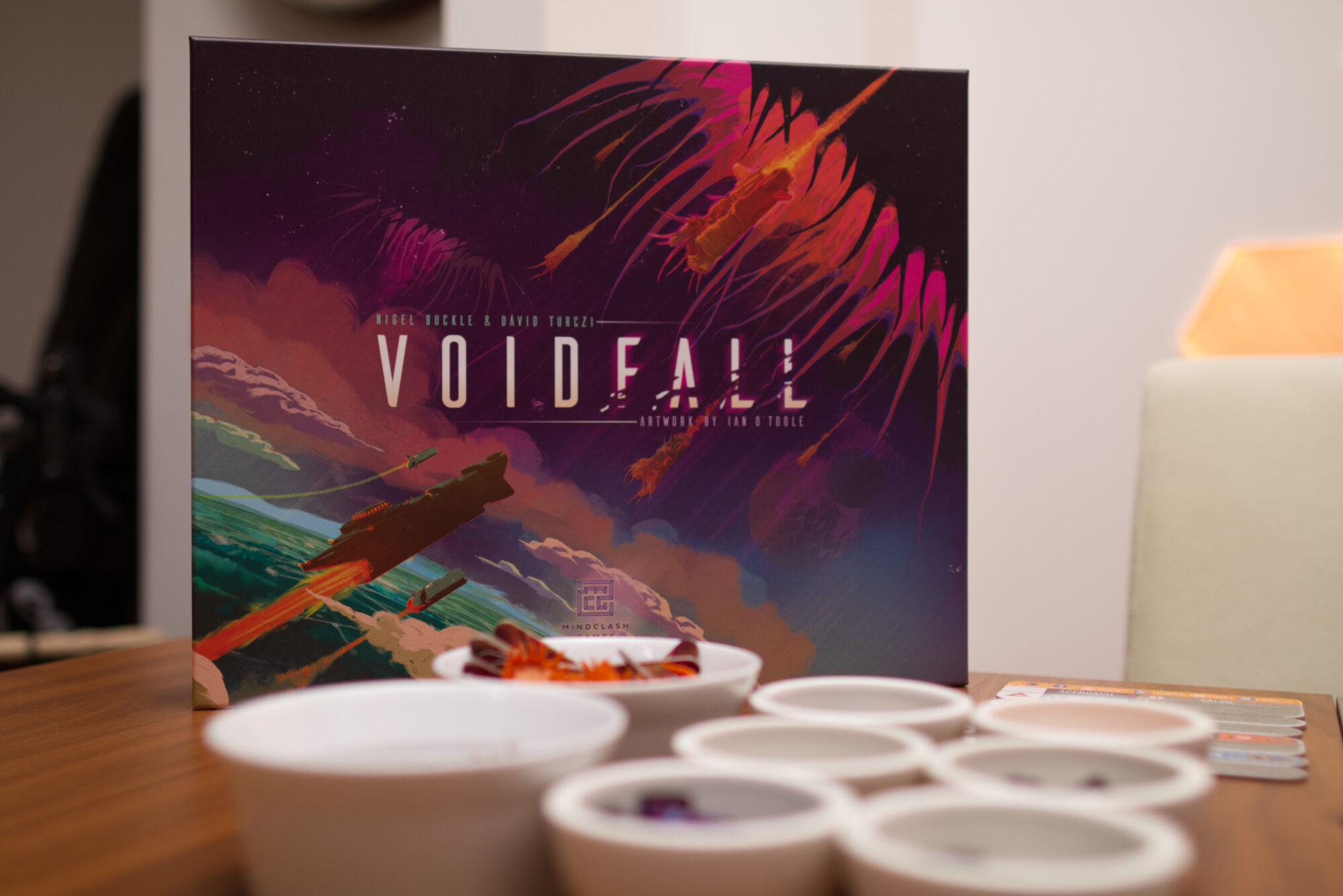It all started when the sheer gigantuous box that is the Galactic Edition of Voidfall arrived at a good friend’s doorstep after many months of anticipation. Would I be interested in playing it? Of course! I had been close to backing Voidfall myself but ultimately decided not to, mainly because I couldn’t decide whether I wanted the minis or not and I was doubtful how often I would get an epic space game to the table. I’ve played Eclipse like once, Cosmic Encounter 2-3 times literal decades ago, and Twilight Imperium not at all. My fondest memory of space-themed games was an all-day session of Avalon Hill’s Stellar Conquest (where if memory serves me well the first 1/3 of the game there was NO player interaction but still it was glorious) and Ryan Laukat’s Empires of the Void II. I still plan to write about the latter at some point because there are so many interesting game design ideas in that single game, it’s a shame its theming suggested one thing to potential buyers when its gameplay delivers an appealing but very different experience.
So far, there wouldn’t have been much of a story here. I would have played it 2-3 times at my friend’s, enjoyed my time, and moved on to other games. The interesting part is: I didn’t like my first play at all! It was mentally exhausting, too many moving wheels for me to really be able to form and then execute something that at least had the appearance of a plan, and everything related to the theme felt slightly off. But when we had packed it away and I left my friend’s house, the gears in my head were turning: how do you grog this game? What’s the meta game like when you have mastered the fundamentals? What if next time I …?
So I organised myself a copy and dug in.
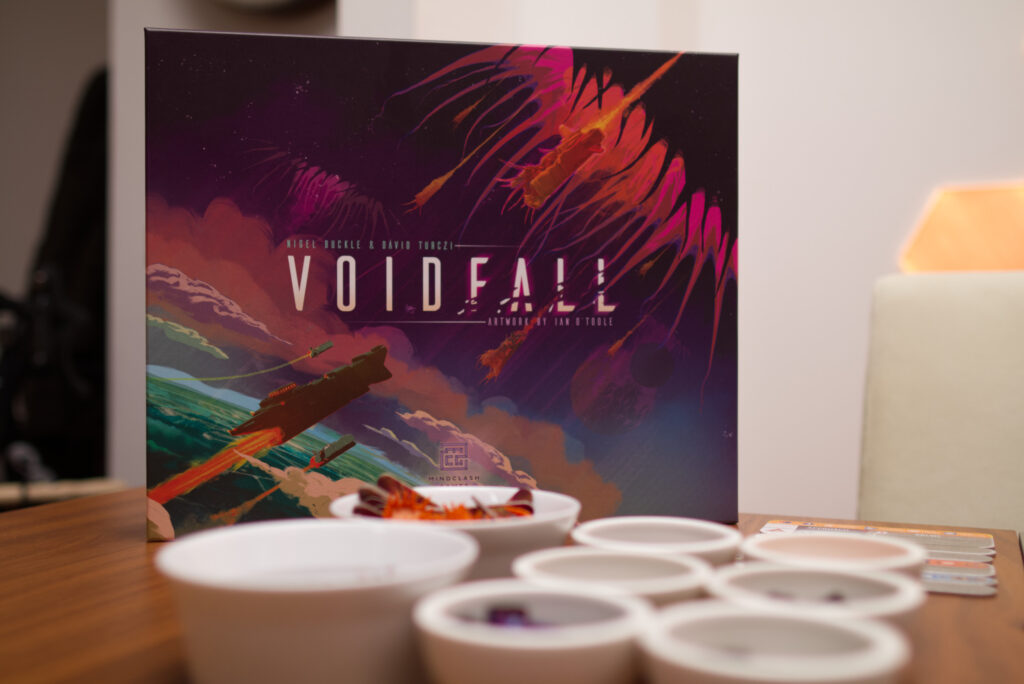
Setup
There is a LOT of content in this box: player action cards, house-specific action cards, solo and co-op mode specific action cards, event decks and the alert deck to decide from which event deck to draw, technology cards, fallen houses cards, cycle cards, agenda cards, … and that were only the types of cards! There are multiple mats for the various houses players can play, resource indicators, production trackers, victory point trackers, a couple of plastic bits, and so on and so on. Right from the moment of opening the box, Voidfall makes it very clear it’s designed to be an epic experience and its setup is an undertaking that shouldn’t be taken lightly.
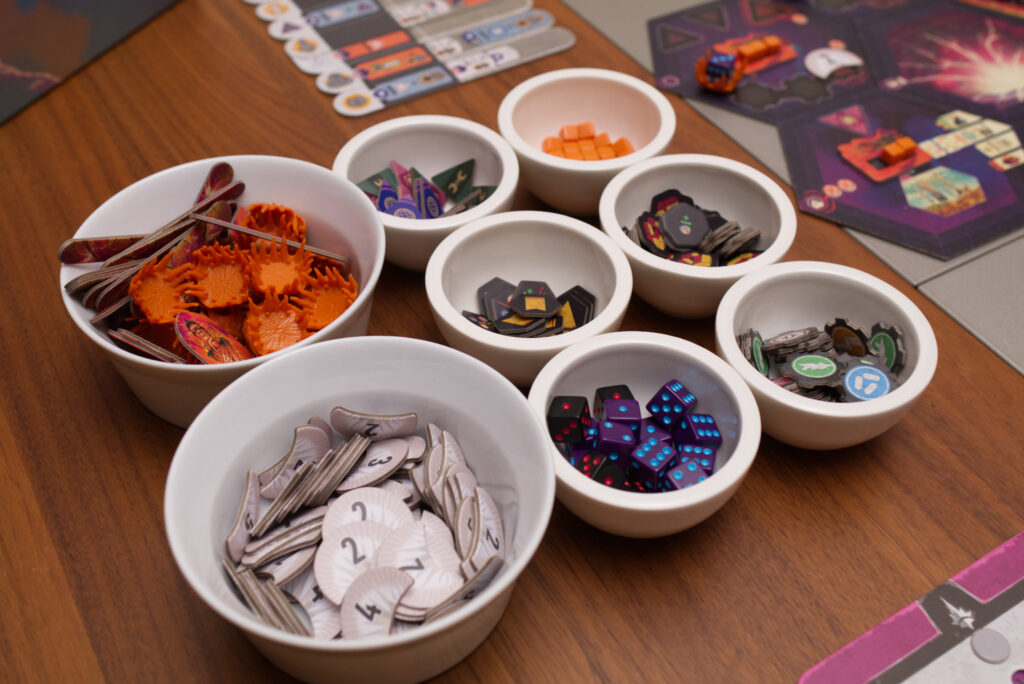
First, players must decide if they want to play solo, co-operative or competitive, and then based on player-count choose one of the included scenarios. This presented the first surprise for me as a new owner of Voidfall: while the separate scenario book is a sizeable ring-bound book, there aren’t actually that many scenarios for any single player count. For example, if your group consists of three players that want to play competitive, there are 11 scenarios for you to choose from. If it instead wants to play cooperative, it’s only six. At first, I was a bit disappointed to learn this because I had bought my own copy just for solo play and 8 scenarios sounded like not that much. However, I came to think of them more like Ticket to Ride maps and less scenarios. They have only a minimal amount of “story” to them and no special rules. Voidfall is more like a giant sandbox where basically any configuration of space and obstacles will work, they might just not be as well balanced as the included designed & tested scenarios.
Let’s start with the map. The game comes with a whole bunch of larger-than-Catan-sized hex fields that for the most part show normal default space on the front and a special part of space on the back. These range from asteroid belts and wormholes to giant rifts in space were Voidborn, the big baddy of the game, thematically emerge. A hex can have up to three slots for shipyards and defences towards the top, up to three slots for guilds (=production buildings) at the bottom, a die to count the population of that system plus various other effects for the special hex tiles.

These are arranged according to the scenario book with on occasion some impassable barriers between hexes. Then a whole bunch of other bits and bops are placed on the map, from small bonus tokens for the first player to conquer the system to pre-installed defences and fallen houses which provide free technologies when defeated. The three most important things are a system’s population size (which will affect the amount of its production), bonus tiles that provide VP for conquering a space (white half-moons with a number on them) and the Voidborn fleet. Pretty much every hex will have someone in there taking claim of that part of space and player’s will have to defeat them to take ownership. While player ships are always blue (double-layer cardboard tiles in the Standard edition or gorgeous grey minis on plastic stands in the Galactic edition) and transparent cubes are used indicate who they belong to, the neutral Voidborn feature orange ships and cubes. The other important information is whether or not a sector is “corrupted”, which is indicated by plastic cradles for the population dice.
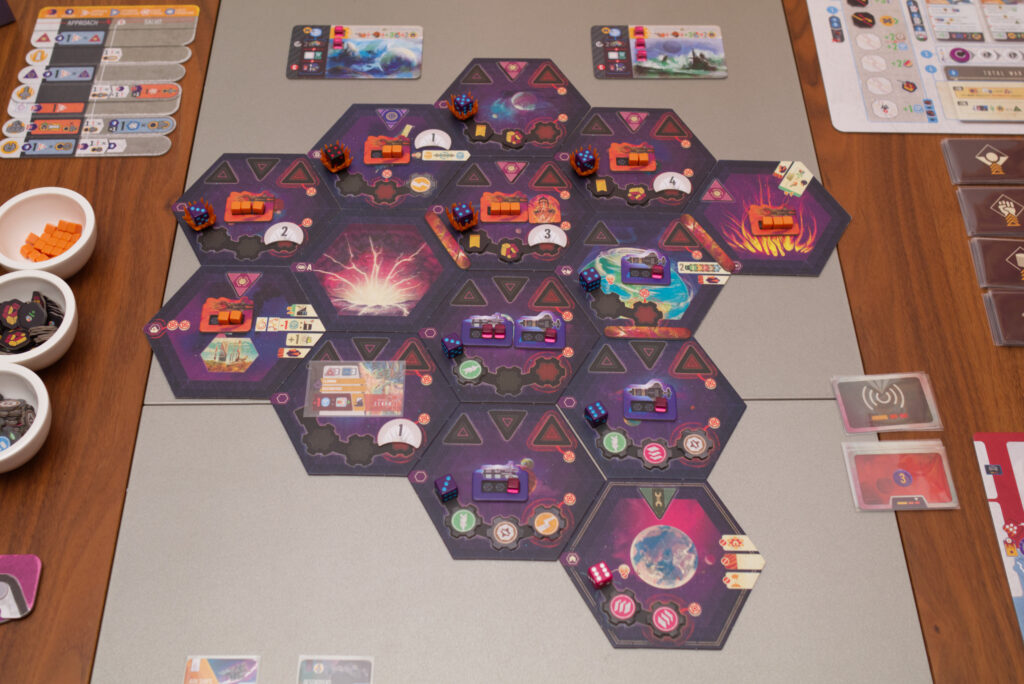
Besides the map, there’s the Galactic Board that not only shows the turn structure but also is home for a couple of other things, chief among them the cycle card. Voidfall is played over three cycles, each represented by a random drawn card. The cycle card shows how many actions each player will get (typically 4-6), what bonus/penalties occur at the start of the cycle and what the reward criteria for a bonus at the end of the cycle are. These range from relative prosperity (things are never just great) to all out war in the galaxy.

Each player also gets a personal “mat” (a large thick paper sheet) to represent the unique house they have chosen to play. The house mat features three tracks of advancement which show a unique-to-them combination of bonuses that player gets when progressing along them. There are two storage areas for the ships-to-be (plastic Pandemic-style cubes) and slots for technologies (top) and agendas (bottom), the latter of which are scoring criteria players can acquire during play.
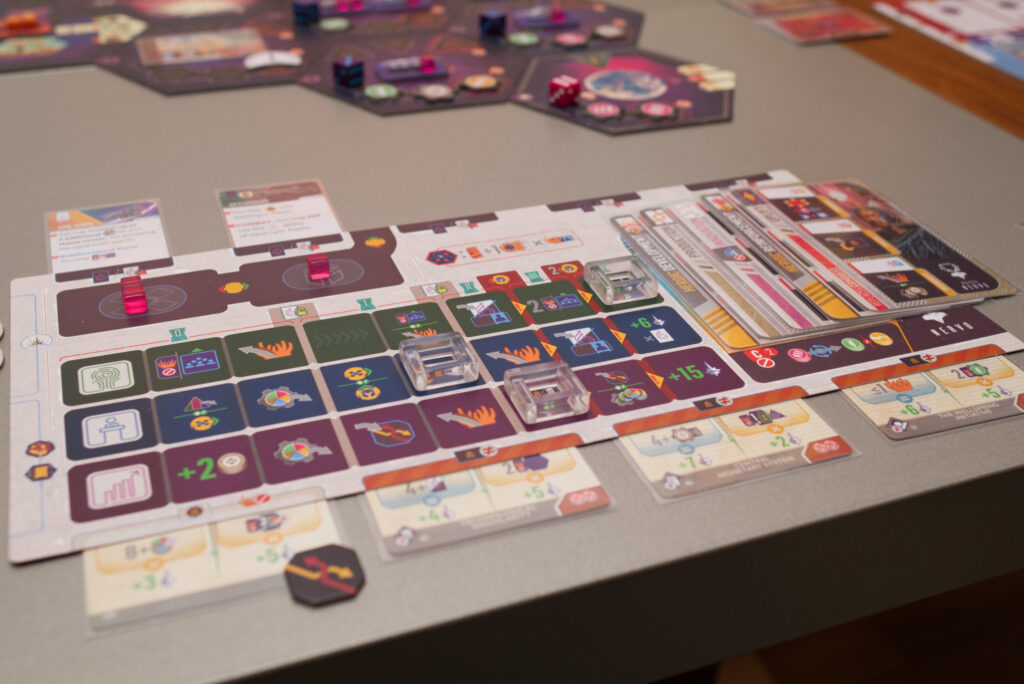
Each player also gets a resource board that acts both as tracker for their resource production capability (left) as well as the amount of resources they own (right). It might seem unusual to have this but it is quite necessary because there are multiple levels of indirection at work here. To figure out how much production of any type of resource a player has, they have to count the number of guild tokens (cardboard gear tiles) of that type in all of the sectors they possess and multiply them with the population size (the value indicated by the die) of that sector. This left wheel of the of the resource board is then rotated to point to that sum in the left cut out and the actual production capacity is shown in the window to the right. When the player then triggers a production of that resource, the amount shown in that window is added to the right wheel which shows the amount of that resource available to the player.
If that sounds like some ancient math device from before the advent of pocket calculators, you’re not too far off. The important bit here is: resource production is not a linear progression. Where it initially might take 2-3 steps of added guild-times-population production on the map to actually result in a single one additional resource to be produced, further down the production wheel a single step may add 2-3 output resources.
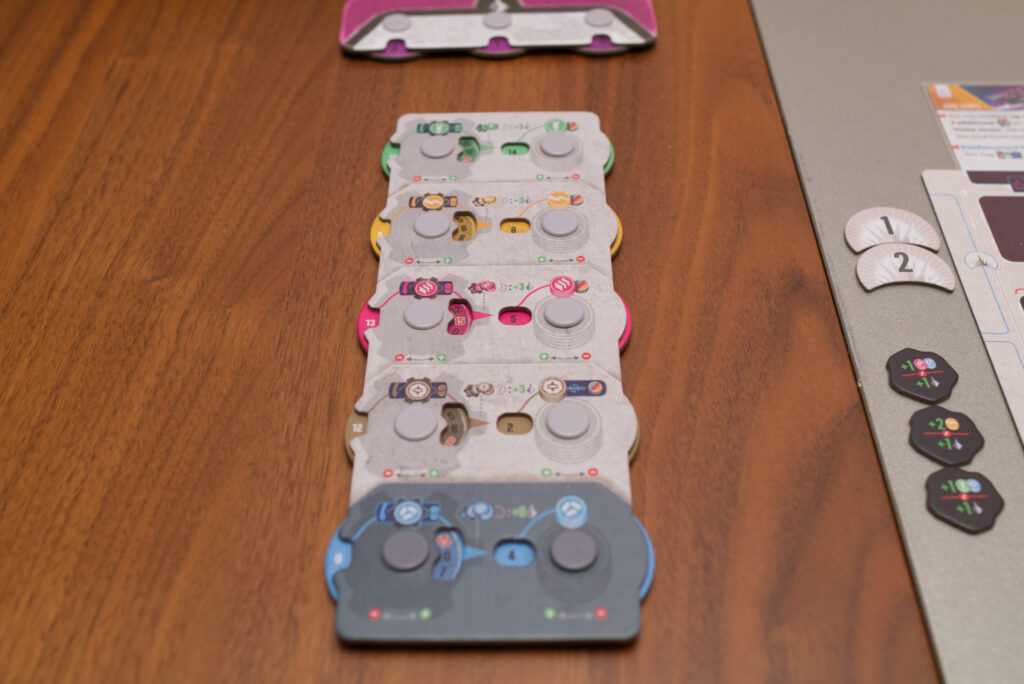
Finally, each player receives a standarized set of action cards, each one showing three possible actions to chose from when the card is played. Depending on the player’s house, they might get a specialised version that replaces one of the standard cards in their set (e.g. swap the standard production for a better one).

I’ve omitted a number of other things that need to happen during setup, such as how it is decided which technologies are in play that session. Suffice to say: setup takes a considerable amount of time. I haven’t timed it but I would say plan for a good 30-45min before the first player can take their very first action.
The Turn
When it’s a player’s turn, they choose one of the cards from their set they haven’t already played that cycle and then pick up to two of the shown actions (three if they previously gained a so called trade token and chose to return it for an additional action).

Each action has a resource cost in the white area and the effects to be gained in the black area beneath it. Let me say it this way: I won’t even attempt to list all the possible effects because there are so many. This is probably a good time to once again laurel the genius of Ian O’Toole when it comes to information design and iconography. While there are so many different things going on here, the iconography is surprisingly readable and logical. Sure, it’s a complex game and players will have to reference the rulebook a lot during their first session, but it’s simply remarkable how quickly players internalise what all those icons mean.
Broadly speaking, actions can be grouped into a bunch of categories: deploying or moving troops, attacking an opponent, triggering a resource production, building new infrastructure, advancing on the tracks on the player board, gaining new agendas, and gaining new technologies.
Production
There is no common income phase in Voidfall. Instead, a player has to play a card that allows them to produce and those actions are only triggering some of the resource types and not all at once. The produced resources are needed to pay for subsequent actions and the types of resources are associated with certain types of actions. For example, if a player plans on increasing the number of technologies they have, they better invest in the blue knowledge resource as all tech-related actions require those. The elephant in the room is the green food resource as players will have to pay food at the end of each cycle depending on how extensive they have build out their infrastructure and agendas.
It is somewhat surprising how few productions are actually needed if a player wisely uses the multitude of other possibilities to get a few resources here, a few resources there. There are bonuses for taking resources, bonuses on the map for the first player to claim a sector, bonuses on the cycle cards, bonuses on the advancement tracks, etc. In general, taking a production always feels like a wasted action and each action counts when players have so few before a cycle ends. But there is always the danger of running out of a certain resources and therefore not being able to perform the actions that were needed to achieve a bigger goal.

Technologies
Voidfall comes with a whole bunch of technologies, each of which comes in a standard and an advanced version. During setup, 8 technologies are chosen to be in play by drawing fallen houses cards and using the techs printed on them. There is a balancing mechanism in there to prevent that too many or too few combat techs are used. In addition, each player’s house adds one more technology to the pool which that player gets for free as part of setup.
There is no prerequisite or cost to take a new technology except for spending the action (and playing the appropriate card) to do so. Instead, a player even gets an immediate bonus just for taking it. The techs come in a variety of styles, from new ship types to additional resources or population increase when playing a certain action card.
For each tech, there are three cards: two standard level and one advanced level version of that technology. To get the latter, one has to first purchase the standard level and also advance on the player board tracks to a certain level to be allowed to pick up an advanced tech. Of course those are super powerful and getting one early can be a huge benefit.

Agendas
The agenda cards can be picked up from a common market and are split into four types. To play them, a player needs to use an action card of a certain type (e.g. “Production”) and then the agenda can be slotted under the player mat as a free action.

Each agenda card provides an immediate bonus when slotted in which can be quite substantial like gaining an additional attack move. Their main effect though is that each shows two criteria that when fulfilled provide VP at the end of each cycle. This can be things like number of technologies owned or population in all of the player’s sectors. The important part here is to pick those up that fit to what one is doing while they are still available. For example, if a player has build a lot of food production guilds and agenda comes that that rewards this, they sure as hell should snatch the card up as soon as they can or another player might take it out of spite.

Combat
One of the key selling points of Voidfall is that its combat is completely deterministic, much in contrast to the vast majority of other space-themed conquest games. If a player moves ships into an occupied sector, they know exactly what the end result will be … although figuring that out can be a bit tricky at times.

Each ship token (or plastic mini in the Galactic version) represents a convoy of ships and each cube on them one ship in that convoy. A player can only have a maximum of two convoys of the same type in a sector and each convoy holds 1-3 cubes. Convoys of the same type can be split or merged at any time. Once the last cube of a convoy is removed, the cardboard token is simply returned to the supply as well.
Combat is split into an approach phase followed by one or multiple salvo phases. The standard ship type does nothing in the salvo phase, but for example defence installations players can construct will deal one point of damage each. The more advanced ship types either contribute or defend against attacks in the approach phase. For each damage dealt, one cube is removed from a ship token. So if two standard ships attack a sector with a defence installation (red triangle tile), one of them will be destroyed before it even can start fighting.
In the salvo phase, ships similarly deal damage and for some ship types may even block it. Otherwise players simply count the number of damage they deal and receive and remove cubes, then repeat the process. There is also an initiative mechanism that decides which side fires first. But I won’t go into any more details here. It suffices to know that a) it’s deterministic and b) gaining access to new ship technologies may either make attacks or defending possible with fewer ships.

The Voidborn
The thing that has been almost absent in all discussed so far are the Voidborn themselves, the titular big baddy that has fallen upon the galaxy. Thematically, the Voidborn have once dominated the galaxy but now have fallen weak such that the player houses can reclaim space.
Mechanically speaking, the Voidborn are in large parts “just there”. They never move ships on the map but instead do skirmishes at the end of a cycle where they out of nowhere attack player sectors. Think of them more like a combination of pollution and natural disaster: you need to clean it up and sometimes it strikes, in this case at the end of each cycle.
Similar as with combat, their behaviour however is completely deterministic. They basically attack each player’s single sector that is least defended and where they do the worst damage. The strength of the attack has to do with how much corruption (those plastic cradles dice are placed in) that player has gathered as side effects of the actions they did, not the strength of the fleet of neighbouring sectors or anything like that. The Voidborn also do not lose any ships on the map when doing these skirmishes. As a result, they feel like coming out of nowhere.
In solo and cooperative mode, all of this feels somewhat odd/unexpected because there is no tangible opposing force in the game. Yes, they are in the way but the things on the map don’t actively fight the players, they only defend. In competitive play, they are just something that has to be dealt with while the real thread lies in the other players.

Cooperative & Solo Mode
When playing solo or cooperative, a completely new element is added to the game: events. Unlike other games, there isn’t simply one event deck but multiple levels of events and a separate deck to randomise what level of event is drawn when. At the start of each cycle, depending on the chosen level of difficulty, a small deck is created with cards that indicate if a war (a surprise attack from the Voidborn) or an event is drawn and of what level. So if at the start of a round the top card is revealed and it shows a two, all players that round have to draw a level 2 event and deal with it.

Events either relate to military aspects or economical aspects (top and bottom row of the event board) and they are never good. Instead, they contain a condition any of the players must meet to discard it as well as an alternative price that can be payed to discard it immediately (e.g. remove some technologies, spend resources). The more cards are collected on the event board, the more dangerous the skirmishes of the Voidborn get and the more resources each player has to pay at the end of a cycle in addition to the usual food cost.

The events give players something to worry about as compensation for that the Voidborn themselves are mid-cycle rather dead in the water. What happens instead is a nice piece of collaboration in that one event might be difficult for one player but easy to achieve for another. This produces conversations like “if you do this, I can take care of that event, but we need to do it before X happens”. It’s the proverbial wrench thrown into the players’ gears that forces them to change their plans midstream and adapt.
Scoring at game’s end works by combining various weighting factors for things the Voidborn still own, like the number of occupied sectors, population within, rifts controlled, etc. If all players have at least that many victory points, they win. If one or more players have a lower score, all lose.
What works well with 2+ players can be a slight problem when playing solo. Each house has two strategies a player can chose from, one typically leaning towards military and the other towards a bustling economy. The impact of the military events however is so detrimental that this almost forces the solo player to not go for a heavy economic strategy. The effects of the random draw are also amplified because with multiple players, chances are high someone can do something against a new event where the solo player might be hit by something that completely works against their strategy.
Standard/Retail vs Galactic Edition
During the Kickstarter, Voidfall was offered in two editions: one with minis and one without. The latter Standard edition is also the version that’s now available in retail.
The minis of the Galactic edition definitely look glorious, there’s no doubt about that. It can be a bit fiddly to get them on/off their stands and not accidentally knock something over when placing/removing cubes from underneath the mini. Overall they work well and if you’re willing to pay the increased price, they are great to have. The biggest con for me personally against them (besides all the plastic) is the increased box size. While the Standard edition is roughly shaped like an Eagle Gryphon Vital Lacerda box (e.g. Kanban EV, Lisboa), which is already sizeable, the Galactic edition’s box is basically 2-2.5x the height. I already had problems finding a space for Foundations of Rome, so getting the Galactic Edition was simply out of the question for me for that reason alone.
Besides the minis, there are some additional differences. The most important: the Galactic edition has triple layer (basically double sided dual layer) hex tiles with slots for the guilds and installations as well as slide-in boards for the house mats. The Standard edition instead has simple plain cardboard tiles and no slide-in boards. Instead of the minis, it comes with dual layer ship tokens which I actually quite enjoyed.
Everything else is pretty much the same: the same cards, the same resource and VP tracker boards, the same corruption cradles. The barriers and Voidborn meeples (the humanoid, not the cubes) are cardboard in one and minis in the other edition. But overall, I think the standard edition is the one to get. It’s cheaper, takes less storage space, and I actually found the handling and overview with the cardboard ships better than with the minis.
The Kickstarter also offered an optional metal add-on to replace the guilds and installations. I’m a big fan of metal coins in games, but same as with Perseverance, I didn’t like the metal bits at all. To me, they just look tacky, but others love them.

Conclusion
More than with any first impressions I’ve written before, this one requires a huge disclaimer: I’ve played Voidfall solo and cooperative, but never competitive, and I imagine it to be a very different game at that. I also left out A LOT of details (trade tokens, turn order, stock piling, safe havens, tutorial, starting agendas, harbingers, …) and mechanisms in the description above. There is a lot going on in this game and the best I can do is provide you a general feel of how it is to play Voidfall.
Let’s start with Voidfall’s theme. I typically very much appreciate juxtapositions like Maglev Metro looking like a cute game about trains and in actuality being absolutely cutthroat. With Voidfall, the combination of space theme and Euro gameplay unfortunately didn’t work for me. While I can appreciate the design and the mechanisms the designers crafted, I kept wondering if I might have liked this game more with a different theme. It reminded me of how Tapestry and Mosaic both used the elements of a civilization game but then created something that is not fulfilling what most players would expect from a civilization game. Take for example the technology cards: while I liked the variety and ideas presented in them, the simple fact that they also provide an instant bonus screamed “combo-Euro” to me, much more than it said “hey, you just got a cool new technology”. Same for the event cards: no flavour text, no nice illustration that steers the imagination.
The fact that the Voidborn never move their ships also pulled me out of the thematic emergence because it didn’t feel like they were really there. I would for example have appreciated it if at least the strength of the end-cycle skirmish would have related to the number of Voidborn ships in my neighbouring sectors or something like that. I imagine this all being less of an issue in competitive play because the Voidborn are just potential stumble stones on your path to battling the real enemy.
So what about the mechanisms themselves? Well, with the pedigree both designers have, it’s no wonder Voidfall is an expertly crafted Euro. The mechanism of the Focus cards (I just called them action cards for simplicity) is interesting and allows for a lot of interesting combinations. I like the battle system and how different the technologies and ships feel with a minimum of rules changes. I also like the advancement tracks on the house boards and how they together with the starting technology of each house will guide players on quite different paths to victory.
Overall though, I have to say Voidfall simply is not my taste of game design. In software engineering, there is this saying: any problem can be solved by adding another level of indirection/abstraction. I was thinking about this a lot while playing Voidfall and how certain games seem to be more additive designs where others are more reductive designs. Voidfall seems to be very much in the former category, an attempt to create an even better game by adding to it. It adds so much that Voidfall almost becomes a lifestyle game, a giant, intricate sandbox which those that love it can play in forever. But despite the very well done manual and the excellent information design by Ian O’Toole, it’s still a lot to grog.
Especially during early plays, having to battle with the choice of which of the 9 focus cards to play and then which of the actions to use would already have been a lot. But here, one also needs to take the resource cost into account. This produces a constant “if I do this, than this, then … oh, I’d be missing a yellow for that. So instead if I …” that seriously gave me mild headaches. I can’t remember an instance of heavy AP in myself that was as severe as my first 1-2 plays of Voidfall. And this mental arithmetic contributes a lot to the feeling of being exhausted instead of having a good time playing an epic space battle.
By playing repeatedly, I came to a point where I was able to form plans, see Voidfall more cycle-by-cycle rather than turn-by-turn (the randomness of the events was too much for me to really form a fixed strategy for the whole game), beat the solo mode confidently. I could pull bigger combos and not run into resource problems. But still, every time I played it, I afterwards felt exhausted and thought about what I could have done with those hours instead. I like playing heavy game’s like those of Vital Lacerda or things like John Company 2nd Edition, so it’s not the complexity that’s bothering me. In Voidfall, there are just too many little gears and levers in play for me to enjoy the game behind them.
I had hoped that at some point the game would be more about reading the map and seeing opportunities, but that never materialised for me. While the variety in map tiles is great, it never played out as the epic space battles I had envisioned when I bought the giant box. All those mechanisms and details were in the way of experiencing the bigger picture. In that sense, Voidfall to me feels more akin to a Barcelona than an Eclipse: an efficiency race that can be replayed over and over again, but at the end I won’t have a great story to tell. And for that, I rather play Barcelona because it’s simpler to get to the table and I have more of a good time. However – and I’m saying this unironically – if you are explicitly looking for a heavy competitive (wouldn’t recommend it for co-op) Euro-style game to sink your teeth in, don’t mind AP-proneness, and the space-theme coat of paint is a bonus, Voidfall might be your game of the year.
